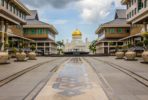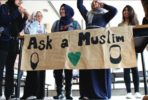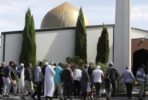VICE News produced a world exclusive when filmmaker Medyan Dairieh spent three weeks embedded alone with the Islamic State in June 2014, gaining unprecedented access into the heart of the self-proclaimed caliphate. Here he describes what he learned.
The two armed men were surprised to see me. No journalists had come this way before. After days of waiting and one failed attempt, I had finally managed to reach the first checkpoint guarding territory controlled by the group known as the Islamic State of Iraq and Syria (ISIS).
By the time I left, about a fortnight later, its ruler, Abu Bakr al-Baghdadi, had claimed for himself a title which brought with it a new religious and political authority — caliph. The so-called caliphate was declared a year ago, on June 29, while I was there. And from then ISIS became known as the Islamic State (IS).
While I had been waiting for the signal to cross the border, ISIS had seized Mosul, Iraq’s second largest city. Until then, the group was widely perceived to have been on the back foot, having withdrawn in the face of advances from other rebel groups in Syria.
But its surge into Iraq and the declaration of the “caliphate” re-established the group as a threat, not only to Iraq and Syria but also to the wider Middle East. But who are they? Where did they come from and what do they believe? I wanted to find out.
Back at the border, the two guards at the checkpoint summoned another, who seemed to have been expecting me. He spoke into his radio: “The guest has arrived, the guest has arrived.”

Dairieh and a young European fighter who works in the IS media center in Raqqa, Syria. Photo via Medyan Dairieh.
Abu Jindal al-Iraqi
It had been nearly 10 years since I first met Abu Jindal al-Iraqi during the Second Battle of Fallujah — six weeks of bloody urban combat at the end of 2004 that pitted Iraqi insurgents, including al Qaeda, against US Marines and their Iraqi and British allies.
Al-Iraqi was a commander in a makeshift artillery brigade that was fighting against the Americans, but not yet affiliated with al Qaeda. He was a former colonel in Saddam Hussein’s Republican Guard, which was disbanded in 2003 in the wake of the US-led invasion of Iraq. He was then clean-shaven and not particularly religious.
Overnight, thousands of men like al-Iraqi lost their income and their status. Many of them took their military training — and in many cases their weapons — and joined the resistance.
When I met him again, inside the border in June 2014, he was wearing a full beard and was in every aspect of his appearance a committed Islamist. In the decade since we met, his militia first had merged into the Islamic State in Iraq, al Qaeda’s local franchise, which then went on to found ISIS. He is now a senior IS commander.
Al-Iraqi’s story is a common one. Internal IS documents obtained by Der Spiegel show not only that the core leadership of the group is made up of former Baathist officers, but that the organization is also run along the lines developed by Iraqi military intelligence.

A former al Qaeda fighter, who became a member of ISIS, shows off his al Qaeda inscribed gun in Aleppo. Photo by Medyan Dairieh.
The Birth of IS
IS’s force is composed of three primary groups: Islamic State in Iraq (based around former Iraqi military men), elements of al Qaeda from the Afghanistan school, and forces from Chechnya and the Caucuses, led by Abu Omar al-Shishani.
On an earlier visit to Syria, in 2013, I met with Al-Shishani. He was extremely busy and distracted, trying to negotiate between ISIS and the Nusra Front. At that time, tensions were coming to a head.
Abu Bakr al-Baghdadi, then the leader of the Islamic State of Iraq, sent one of his most trusted lieutenants, Abu Mohammed al-Jolani to Syria in 2011 as mass protests against the Assad regime spread. His task was to form the Nusra Front, the Syrian affiliate of al Qaeda.
Al-Jolani and al-Baghdadi later fell out over the direction of the Nusra Front. Al-Baghdadi wanted Nusra to be an extension of the Islamic State in Iraq, and to fall under his command. Al-Jolani wanted to focus on fighting the regime, work with less radical groups, and win hearts and minds. The two men apparently held talks in Aleppo.

Aleppo in 2012. This was one of the first times that this ISIS badge (on the right) and this flag (associated with the group) were seen in Syria. Photo by Medyan Dairieh.
Al-Jolani won the support of al Qaeda’s leadership, thought to be based in the borderlands between Afghanistan and Pakistan. I heard that IS tried to send a Libyan member to talk to al Qaeda’s leadership in Afghanistan. The man had difficulties in getting there, however, making me realize that IS’s contacts with al Qaeda leadership were very weak.
When the split occurred, foreign fighters — including al-Shishani’s Chechens and an experienced group of Libyans fighting as the al-Battar battalion — overwhelmingly pledged their allegiance to IS. Later, when I went to Libya, I met members of the al-Battar battalion who had returned to fight there.
I believe the muhajireen, as the foreign fighters are known, did not really come to Syria to resist Assad. They came because they saw themselves as soldiers of Islam, and believed it was their religious destiny to build the caliphate.
Nusra worked with the other rebel groups, participating in joint charity organizations and fighting alongside them. ISIS worked only through its own organizations.
On 22 February 2014, ISIS assassinated Sheikh Abu Khaled al-Suri, a leader of Ahrar al-Sham, a Salafist militia allied to Nusra. The Nusra Front then declared war on ISIS.
In the wider Middle East, however, it is IS that has attracted the most new support, including militants from Egypt, Yemen, Libya, not to mention many other parts of the world.
In Raqqa
I arrived in Raqqa, the IS capital, shortly after crossing the border. There was a military parade on, which I learned had been timed to coincide with my arrival.
Before the war, the town was liberal, with a large Christian population. People would go out in the evening to drink and smoke. There’s no music on the street now and even the pictures are covered — it has completely changed.
There are people from more than 80 nationalities living in Raqqa. Children under 15 go to religious instruction classes. After the age of 16, they go to the military camps for training. After 16 they can join the fighters.
During my time in Raqqa, I was accompanied at all times by a media team.Although IS has been praised for the quality of their video productions, there are actually very few skilled media workers among them. There were a few who’d worked for TV channels, however, and some foreigners with their own expertise. From what I saw, their equipment was mostly basic and the internet very slow, but they worked long hours, sleeping between three and five hours a night, and keeping a seven-day schedule.
I learned that support from abroad, especially from Libya, was greatly important in publishing material online. One of the media team also told me that a young woman in the UK had also been helping them with this for a few months.
They also use more basic means of propaganda, such as publishing texts online, distributing CDs with films, and driving trucks around blaring out speeches by al-Baghdadi and Abu Mohammed al-Adnani, an official IS spokesman.
IS was initially hostile to international media coverage, but as its members started to notice the world’s huge interest in them, they decided to establish a number of media departments, including most prominently Al-Furqan. They also set up a media office in every province of their “state,” with each department linked to the local preacher’s office.
Watch the VICE News documentary, The Islamic State here:
At around 2am on July 4, I awoke to the sound of gunfire and explosions. Those with me from the media department strapped on their explosive belts, grabbed their rifles and rushed out without uttering a word. Everything was dark, as if there was a blackout.
A few hours later, I learned that US special forces had assaulted a IS camp outside Raqqa. They had apparently hoped to rescue a number of Western hostages who were later killed by IS. The hostages weren’t there, and the troops withdrew empty handed after killing eight IS members — including, I was told, trainee leaders from Tunisia and Saudi Arabia.
IS also believed that Jordanian troops also took part in the assault and showed me a bloodied scrap of a military uniform bearing Jordanian insignia.
IS Military Doctrine
IS has proved adept at fighting and unconventional war, combining tactics from the Taliban, handed down through al-Zarqawi, with the expertise of former Iraqi military officers.
It has tried to expand the battlefront to exhaust air support, using short-range rockets and missiles, for which officers from the former Iraqi army helped set up inexpensive, hand-made mobile launchers.
In an attack, the remnants of al Qaeda and suicide groups will be the first troops to mobilize, to strike the advancing forces with suicide operations. The leaders of the former Iraqi Republican Guard will direct other groups to guard their positions and ensure rocket and missile bombing operations are carried out.
IS has also adopted a three-pronged Taliban military doctrine, Firstly, it strikes the enemy to confuse them, wear them out, and weaken them. Secondly, it obtains supplies such as weapons, money, and food supplies. Thirdly, it claims a media victory to grow the organization’s popularity.
The success of this approach was evident last summer. In the blink of an eye IS built a state the size of Jordan. It seized large quantities of weapons, including heavy weaponry and all kinds of other sophisticated equipment, and a significant amount of money. IS was able to claim that they broke the 100-year-old Sykes-Picot Agreement, a colonial-era agreement which defined the frontier between Syria and Iraq, by opening up the borders. This gesture sent a message to zealous Islamist youth that IS is leading a global jihad.
The group does face challenges. They have difficulty obtaining spare parts and supplies to maintain their heavy weapons, and problems manufacturing enough of the car bombs whose en masse deployments have been the prelude to many devastating assaults, including the capture of Ramadi in May. They are forced to fight on multiple fronts: against the Iraqi army, against the Kurds, and against Syrian rebels — as well sometimes against the Syrian regime.

German and Finnish IS fighters. Photo by Medyan Dairieh.
But IS realizes it is now engaged now in a crucial battle and not simply sharpening its talons. For this reason, it will try to prolong the battle, and open numerous fronts and lines of fighting in regions that are far from one another. It will do this in order to disperse enemy forces, to be able to attack them far from their reinforcements, and to be able to attack their supply convoys, which are generally on the defensive.
IS believe it is their destiny to face their most powerful enemy, America, on the field of battle. An IS military commander, an officer from Hussein’s former Republican Guard, told me that IS preparing for an attack, not for defense.
“We will defend our project,” he said, “and this will only be achieved when America feels the necessity to confront us on the ground — this is what we want and what America fears.”
Departure
The time eventually came for me to leave IS territory.
They took me to a place near the border. Every night we would go to the border, and look out over a dark, empty space. We would wait for the right time to cross, to avoid the army’s patrols.
We sat, waiting for the all clear. Although they had strong systems to monitor the situation at night, the crossing was nonetheless difficult and dangerous.
One night, at 2.30am as I was sleeping, they woke me up at told me it was time to cross. I left my big rucksack with them as it was bulky and I couldn’t carry it with me.
They walked with me and when I asked why they told me that I was their guest and that they would look after my safety, in spite of the danger to themselves, until I reached a safe place on the other side.
Source: https://news.vice.com







